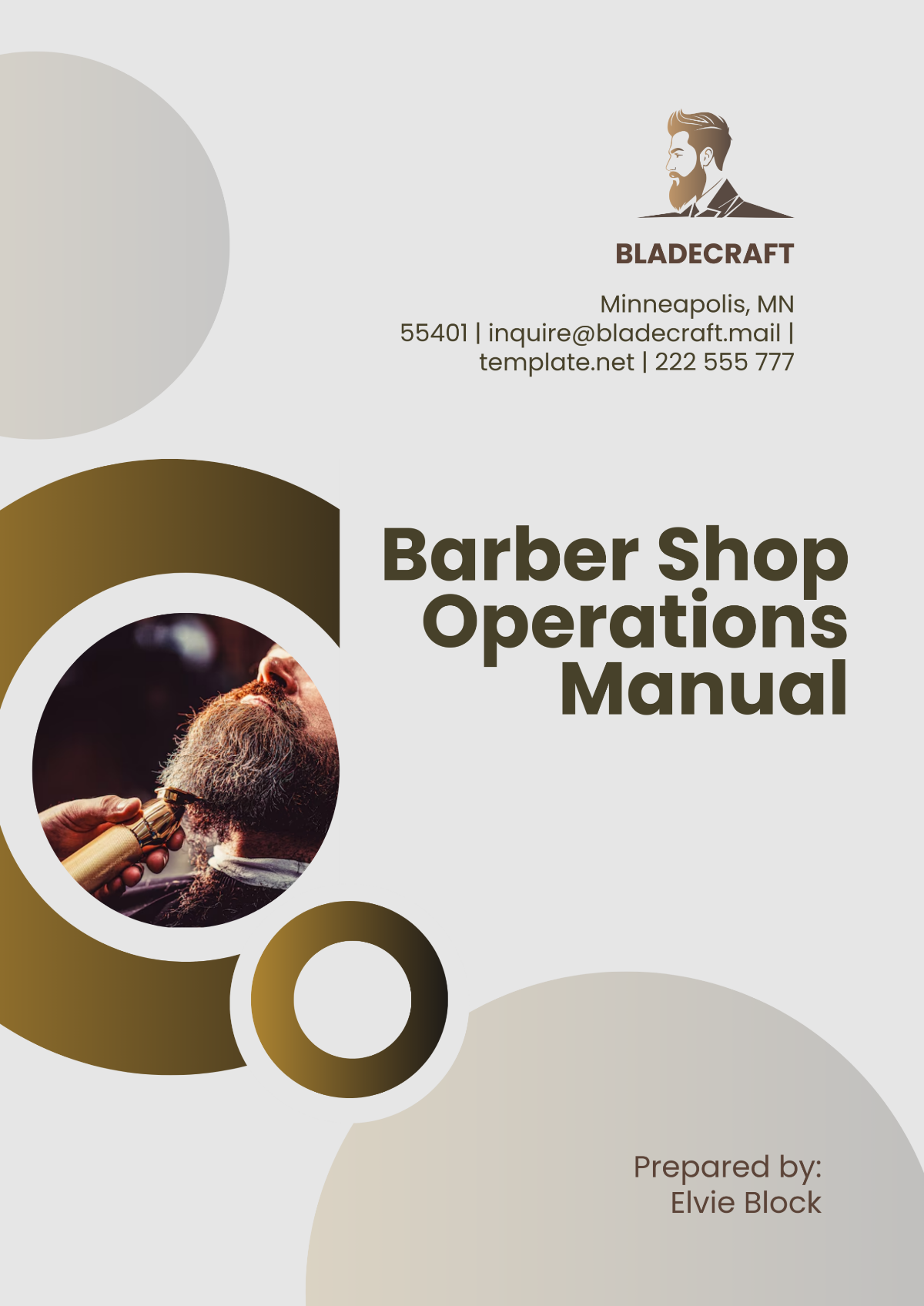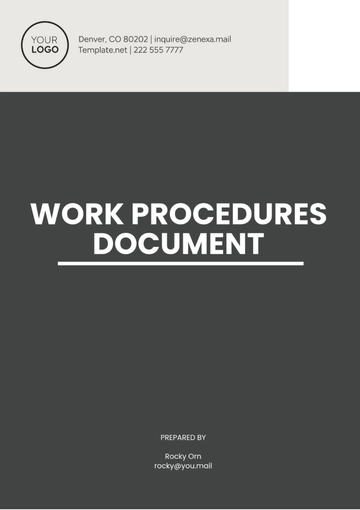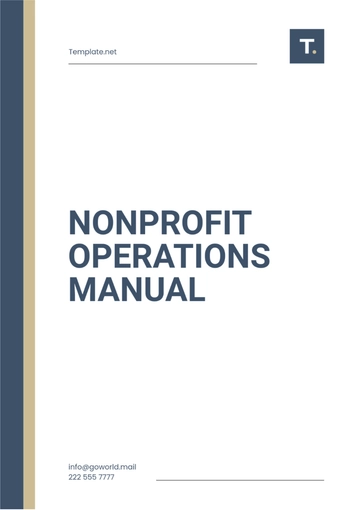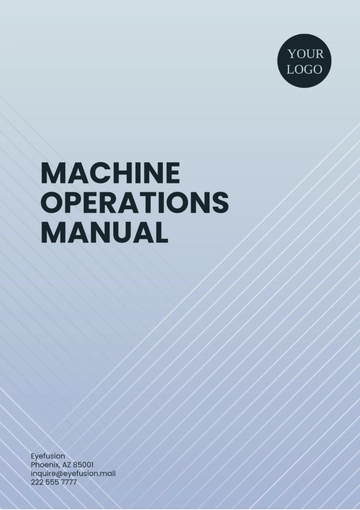Free Barber Shop Operations Manual

I. Introduction
A. Purpose of the Operations Manual
The purpose of this Operations Manual is to provide a comprehensive and standardized guide for the smooth functioning of [Your Company Name] Barber Shop. It outlines the daily operations, policies, procedures, and customer service protocols necessary to ensure that the business runs efficiently and effectively. The manual is intended to help employees understand their roles, responsibilities, and how they should interact with customers, providing a unified approach to quality service. By adhering to these guidelines, the business ensures consistency in its operations, which directly enhances customer satisfaction and long-term success.
This manual serves as a reference for both new and existing employees, providing clear instructions on the operational standards required to maintain an efficient, safe, and customer-friendly environment. Furthermore, it aligns all business practices with industry regulations and company values, making it an essential tool for day-to-day business management.
B. Vision and Mission of [Your Company Name]
Vision: The vision of [Your Company Name] is to become the leading barber shop in the area by providing high-quality grooming services with a focus on customer satisfaction and innovative techniques. We aim to set new standards for what a modern barber shop can offer, blending tradition and technology to create an exceptional experience for our clients. By the year 2050, we envision our brand becoming synonymous with excellence in the grooming industry.
Mission: Our mission is to offer premium grooming services that cater to the individual needs of every client. At [Your Company Name], we believe in creating an atmosphere where customers feel welcome, relaxed, and confident. We are committed to providing a clean, safe, and inclusive environment where our highly skilled team delivers top-notch barbering services using the best tools, products, and techniques available. Our focus is on building long-term customer relationships through exceptional service and a positive experience.
C. Scope of the Manual
This Operations Manual applies to all employees, contractors, and stakeholders involved in the operations of [Your Company Name] Barber Shop. It provides detailed policies, procedures, and expectations regarding daily operations, customer service, employee conduct, financial management, marketing strategies, and more. By adhering to the contents of this manual, all staff members will contribute to the successful and seamless operation of the business, ensuring a consistent and high-quality customer experience. This manual should be reviewed regularly and updated as necessary to reflect changes in the industry, technology, and company goals.
II. General Policies and Standards
A. Code of Conduct
Employees at [Your Company Name] are expected to adhere to the highest professional standards, both in their interaction with customers and in their conduct in the workplace. This includes:
Respect for Customers and Colleagues: Every employee must treat others with dignity and respect, maintaining a courteous and friendly attitude at all times.
Professional Integrity: Employees should be honest and ethical in all business dealings. They should be accountable for their actions, and any mistakes should be acknowledged and addressed promptly.
Confidentiality: Employee and customer confidentiality is of utmost importance. All personal information, preferences, and other sensitive data must be kept private and used only for operational purposes.
Commitment to Excellence: Every employee should strive to perform their job at the highest possible standard, consistently exceeding customer expectations.
B. Dress Code and Grooming Standards
Employees must present themselves in a manner that reflects the professionalism of [Your Company Name]. The following dress code guidelines are required:
Employees must wear the designated [Your Company Name] uniforms, consisting of a black or neutral-colored shirt, black pants, and closed-toe shoes.
Personal grooming should be immaculate. Hair should be neatly styled, and beards must be well-groomed. Employees should have clean, trimmed nails and maintain a high level of personal hygiene.
Jewelry should be minimal to avoid interference with work or cleanliness. Tattoos and piercings must be discreet and professional.
During work hours, employees must refrain from wearing hats or any other attire that detracts from the professional appearance of the shop.
C. Safety and Hygiene Policies
Maintaining cleanliness and safety is a top priority at [Your Company Name]. To achieve this, the following guidelines are in place:
Personal Hygiene: All employees must wash their hands before and after every client service. Hand sanitizers should be readily available at stations for quick access. Employees must also ensure their tools and equipment are sanitized after each use.
Shop Cleanliness: The barber shop must be thoroughly cleaned at the beginning and end of each day. The floor must be swept regularly, and hair clippings must be disposed of in a sanitary manner.
Equipment Sterilization: Clippers, scissors, razors, and other equipment must be sterilized between each use using alcohol-based cleaners, UV sterilizers, or autoclave systems. Tools should be inspected regularly to ensure they are in good condition and free from any defects.
Safety Measures: Emergency exits should be clearly marked and unobstructed. Employees should familiarize themselves with the location of fire extinguishers and first-aid kits. Regular fire drills and safety training must be conducted to ensure preparedness in case of an emergency.
III. Customer Service Policies
A. Greeting and Handling Customers
Customer service is the cornerstone of [Your Company Name]. The following guidelines help ensure customers feel valued:
Initial Greeting: Every customer must be greeted warmly within [10] seconds of entering the shop. Staff should introduce themselves, inquire about the customer’s needs, and offer assistance.
Wait Time Management: If there is a wait, staff should keep customers informed of their estimated wait time and offer seating or refreshments. It is essential to ensure customers feel comfortable during their time in the shop.
Service Transition: At the conclusion of each service, employees should ask if the customer is satisfied and offer additional recommendations or services. Always ensure that the customer feels their experience was personalized and valued.
B. Appointment Booking Guidelines
Appointments are a vital aspect of customer service. [Your Company Name] offers several ways for customers to book appointments, including online, by phone, and in-person:
Online Booking: Customers can book their appointments via our website or mobile app. The online platform should be user-friendly, with real-time availability displayed to minimize booking conflicts.
Phone and In-Person Bookings: Staff must verify the appointment details, including the customer’s name, desired service, and preferred barber. If an appointment cannot be made immediately, staff should offer an alternative time and ensure customers are aware of walk-in availability.
Appointment Reminders: A reminder system must be implemented, with customers receiving confirmation and reminders [24 hours] before their scheduled appointments. This can be done through text messages, emails, or phone calls.
C. Complaint Handling
Handling customer complaints with professionalism and empathy is key to maintaining a positive reputation:
Listen Actively: When a customer expresses dissatisfaction, staff should listen without interrupting. It is important to understand the nature of the complaint fully before taking action.
Apologize and Acknowledge: Staff should apologize for the inconvenience and acknowledge the customer's feelings, even if the issue is not the fault of the shop.
Resolve the Issue: Offer a solution that satisfies the customer. This may include a complimentary service, a discount on the current visit, or an invitation for a free follow-up appointment.
Document and Report: All complaints should be recorded in the Customer Feedback Log. This helps management identify recurring issues, improve service, and train staff to handle similar situations better in the future.
IV. Barber Shop Services
A. Overview of Services
At [Your Company Name], we offer a wide range of services designed to cater to the individual grooming needs of our customers. These services include:
Standard Haircut: A traditional cut using scissors or clippers to achieve the customer’s desired style.
Premium Haircut: A more detailed service that includes a shampoo, conditioner, scalp massage, and precision haircut for a premium look.
Beard Grooming and Shaping: Beard trims and shaves, including straight razor services and beard sculpting for a polished, clean look.
Hair Treatments: We provide hair treatments, such as scalp massages, deep conditioning, and color treatments to rejuvenate hair and maintain healthy growth.
Event Grooming Packages: Tailored packages for weddings, special events, or photo shoots, including grooming services for both men and women.
B. Pricing Policy
Our pricing is designed to reflect the quality of services provided, while being competitive within the industry. We have structured our pricing to accommodate both budget-conscious and premium customers.
Service | Price ($) |
|---|---|
Standard Haircut | 25 |
Premium Haircut | 35 |
Beard Trim and Shape | 15 |
Hair and Beard Package | 40 |
Event Grooming Package | 60 |
These prices may vary based on location, stylist experience, or special promotions. Discounts may be offered for bulk services or membership packages, and these should be communicated clearly to customers.
C. Service Procedures
All services should begin with a consultation to ensure that the customer’s expectations are understood. This consultation typically lasts [5] minutes and should cover:
Customer Preferences: Ask specific questions about the style they want, such as length, shape, and texture.
Hair Health Assessment: Examine the customer’s hair and scalp to offer recommendations for maintenance or treatment, such as conditioning treatments or hair products.
Service Customization: Tailor the service to the client’s needs, adjusting techniques and tools as required for a personalized experience.
After the service is completed, it is essential to review the result with the customer. Ask if they are satisfied with the service, offer styling tips, and suggest relevant products or services to maintain the look at home.
V. Equipment and Maintenance
A. List of Essential Tools and Equipment
At [Your Company Name], maintaining high-quality service relies on the proper tools and equipment. The following list includes the essential items every barber must use, and these tools should be properly maintained and cleaned after each use:
Item | Purpose | Frequency of Replacement |
|---|---|---|
Hair Clippers | For cutting and trimming hair. | Every [12] months |
Straight Razors | For precise beard and hairline shaving. | Sharpened monthly, replace annually |
Scissors | For hair cutting and styling. | Every [18] months |
Hair Brushes and Combs | For styling and detangling. | Replace every [6] months |
Shaving Brushes and Cream | For providing smooth shaves. | Replace every [12] months |
Barber Chairs | For customer seating during services. | Every [3] years |
Towels and Capes | For protecting the client and cleaning tools. | Laundered daily, replace as needed |
Each barber station should be equipped with a clean towel rack, a set of freshly laundered towels, a cape for each client, and an apron for the barber.
B. Cleaning and Maintenance Guidelines
To ensure the safety and comfort of customers, all equipment must be thoroughly cleaned and maintained. The following cleaning guidelines must be adhered to:
Clippers and Razors: After each use, all clippers and razors should be cleaned with a disinfectant solution, and combs should be sanitized. Clippers should be oiled regularly to maintain peak performance.
Surfaces and Floors: All workstations and surfaces, including mirrors, countertops, and floors, should be wiped down with a non-toxic cleaner between each customer. Floors must be swept or vacuumed every [2] hours during business hours.
Barber Chairs and Seating Areas: These should be wiped down and sanitized after every use, including the armrests and footrests. Any leather or fabric should be inspected for tears and repaired as necessary.
Towels and Capes: Towels should be changed between clients, and capes should be cleaned regularly. Towels must be laundered in hot water with disinfecting detergent daily to prevent the spread of bacteria.
VI. Employee Roles and Responsibilities
A. Job Descriptions
Each employee at [Your Company Name] is expected to perform specific tasks related to their role. Below are the primary roles within the barber shop and the key responsibilities for each:
1. Barber
Key Responsibilities:
Provide haircuts, shaves, and beard grooming services.
Maintain high standards of hygiene and cleanliness.
Stay current with barbering trends, styles, and techniques.
Engage with clients to understand their needs and provide personalized services.
Manage the tools and equipment required for each service.
Ensure clients are comfortable and satisfied throughout their experience.
2. Receptionist
Key Responsibilities:
Answer phones, schedule appointments, and manage walk-in customers.
Keep track of appointments, ensure time slots are efficiently allocated.
Handle customer queries and direct them to the appropriate barber.
Assist with sales, including booking follow-up appointments or selling hair care products.
Maintain a welcoming and organized reception area.
3. Shop Manager
Key Responsibilities:
Oversee the day-to-day operations of the barber shop.
Ensure compliance with all health and safety regulations.
Manage inventory, including ordering products, tools, and supplies.
Supervise staff and resolve any employee issues or concerns.
Track financial performance, including sales, revenue, and expenses.
Handle customer complaints and ensure a positive experience for all clients.
B. Scheduling and Timekeeping
At [Your Company Name], scheduling is a critical element of ensuring efficient operations and customer satisfaction. The following timekeeping guidelines are necessary:
Shift Scheduling: Employees are expected to adhere to their scheduled shifts. Any changes to the schedule must be requested and approved by the manager at least [48] hours in advance.
Breaks and Lunches: Employees working a [6] hour shift or longer are entitled to a [30]-minute lunch break. Shorter shifts will receive a [10]-minute break after every [2] hours of work.
Timekeeping: All employees are required to clock in and out using the timekeeping system to ensure accurate records of working hours.
VII. Financial Operations
A. Payment Policies
[Your Company Name] accepts a variety of payment methods to accommodate our customers’ preferences. The accepted forms of payment include:
Cash: Payments made directly to the barber or receptionist.
Credit/Debit Cards: All major credit and debit cards are accepted, including Visa, MasterCard, and American Express.
Mobile Payments: We support payments through platforms such as Apple Pay, Google Pay, and other digital wallet services.
Gift Cards: We offer gift cards that can be purchased for specific services or monetary values. Customers can redeem these gift cards for any service or product within the shop.
Membership Packages: Customers can purchase pre-paid packages for a set number of services at a discounted rate, which can be applied over time.
B. Daily Cash Management
To maintain accurate financial records, the following steps must be taken daily:
Cash Drawer Balancing: At the start of each shift, the cashier should count the cash in the register to ensure the drawer is balanced. At the end of the day, the drawer must be counted again and the total logged in the daily cash log
Receipt Issuance: A receipt should be given for every transaction, whether the payment is made by cash, card, or digital method. The receipt will serve as proof of payment and assist with tracking purchases and services.
End-of-Day Reconciliation: The manager should reconcile the total revenue for the day with the register’s cash drawer and payment records. Any discrepancies must be reported immediately, and appropriate action taken.
Bank Deposit: All cash payments must be deposited in the business bank account at the end of the week or as specified by company policy.
VIII. Marketing and Promotions
A. Strategies and Campaigns
Effective marketing is key to attracting new customers and maintaining relationships with existing ones. [Your Company Name] utilizes a variety of marketing strategies to promote the business:
Social Media Marketing: Maintain active profiles on platforms such as Instagram, Facebook, and TikTok to showcase recent styles, customer testimonials, and promotions. Content should be updated regularly, with interactive posts like polls or customer contests to boost engagement.
Local Advertising: Advertise through local newspapers, flyers, and posters. Partner with local businesses to offer cross-promotions, such as discounts for customers who show receipts from nearby stores.
Email Marketing: Send regular newsletters to customers with updates on new services, upcoming promotions, or special events. Maintain a strong email list, ensuring customers opt-in for marketing communications.
B. Loyalty Programs
[Your Company Name] offers a loyalty program to reward repeat customers. The program includes:
Points System: Customers earn points for every service purchased, which can be redeemed for discounts, free products, or complimentary services. For example, for every $10 spent, customers earn 1 point, and [100] points equals a $10 discount.
Referral Program: Customers who refer a new client to the shop receive [10%] off their next service. Both the referring customer and the new client are given discounts as a token of appreciation.
IX. Emergency and Contingency Plans
A. Fire and Safety Guidelines
In case of a fire or emergency, the following steps must be taken:
Evacuation Plan: Employees should be familiar with the shop’s evacuation plan, and customers should be guided to the nearest exit in case of a fire.
Fire Extinguishers: Fire extinguishers should be placed in easily accessible locations, and all staff members must undergo fire safety training.
First-Aid Kit: A fully stocked first-aid kit must be available and regularly checked for expired or used items.
B. Customer Health Emergencies
In case of a medical emergency:
Alerting Authorities: Call emergency services immediately if a customer or staff member is injured or experiences a medical emergency.
Assistance: Provide assistance until help arrives, whether this involves administering CPR, providing first aid, or offering comfort.
Incident Report: All incidents should be documented and reviewed to improve future safety protocols.
X. Compliance and Legal Policies
A. Licensing and Permits
[Your Company Name] operates in compliance with all local and national licensing requirements. We ensure that:
The shop has the necessary business licenses and health permits.
Employees are certified and licensed to perform barbering services.
All equipment is inspected and approved by health and safety authorities.
B. Data Protection and Confidentiality
We prioritize the protection of both customer and employee data. [Your Company Name] follows all applicable data protection laws to ensure the security of personal information. Employees must:
Safeguard customer data, including contact details, payment information, and service history.
Avoid sharing personal data without explicit consent, unless required by law.
- 100% Customizable, free editor
- Access 1 Million+ Templates, photo’s & graphics
- Download or share as a template
- Click and replace photos, graphics, text, backgrounds
- Resize, crop, AI write & more
- Access advanced editor
Ensure smooth operations with the Barber Shop Operations Manual Template from Template.net. This editable and customizable template covers procedures, workflows, and best practices for your shop. Modify it with the AI Editor Tool to suit your business needs. Create your operations manual now!





























